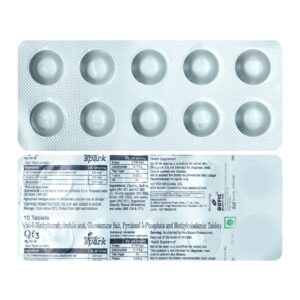METHYCOBALAMIN + PYRIDOXAL-5-PHOSPATE + (6S)-5-METHYLTETRAHYDROFOLIC ACID
Methycobalamin: Methylcobalamin is a synthetic form of vitamin B12, also known as coenzyme B12. It is primarily used as a dietary supplement to treat and prevent vitamin B12 deficiency. It is available in oral tablet or injectable forms.
The mechanism of action of methylcobalamin is to act as a cofactor for various enzymatic reactions involved in the synthesis of DNA, RNA, and myelin, the protective covering of nerves. It plays a crucial role in the formation of red blood cells and maintaining the health of nerve cells.
The dosage of methylcobalamin depends on the individual’s age, sex, and the severity of deficiency. For vitamin B12 deficiency, typical doses may range from 1000 to 5000 mcg daily for the first few weeks, followed by a maintenance dose of 1000 mcg weekly or monthly. However, it is essential to consult a healthcare professional for an accurate dosage recommendation.
Some common side effects of methylcobalamin may include nausea, vomiting, diarrhea, headache, dizziness, and allergic reactions. In rare cases, there may be a risk of hypersensitivity reactions or anaphylaxis. Long-term use of high doses may increase the risk of hypokalemia.
It is important to note that methylcobalamin should be used under the guidance of a healthcare professional, especially in individuals with kidney or liver diseases, as they may require dose adjustments or additional monitoring. Additionally, it is always recommended to inform your healthcare provider about any other medications or supplements you are taking to avoid any potential interactions.
Pyridoxal-5-Phospate: Pyridoxal-5-Phosphate (PLP) is the active form of vitamin B6, also known as pyridoxine. It serves as a cofactor in several enzymatic reactions involved in amino acid metabolism, neurotransmitter synthesis, and glycogen breakdown.
PLP is primarily used as a dietary supplement to address conditions related to vitamin B6 deficiency, such as anemia, neuropathy, and skin disorders. It may also be prescribed as an adjunct treatment for certain medical conditions like premenstrual syndrome (PMS), carpal tunnel syndrome, and nausea during pregnancy.
As a coenzyme, PLP takes part in the conversion of tryptophan to serotonin, as well as the synthesis of dopamine, norepinephrine, and gamma-aminobutyric acid (GABA). It also plays a role in the regulation of homocysteine metabolism, a compound associated with increased risk of cardiovascular disease.
The recommended dose of PLP varies depending on the individual’s age, sex, and specific medical condition. It is typically taken orally in the form of tablets or capsules. It’s important to follow the dosing instructions provided by a healthcare professional or on the product label.
While pyridoxal-5-phosphate is generally considered safe when used as directed, it can cause side effects in some individuals. Common side effects may include:
1. Gastrointestinal issues: Nausea, vomiting, abdominal pain, and diarrhea.
2. Sensory neuropathy: Prolonged use of high doses of PLP can cause nerve damage, leading to tingling, numbness, and pain in the extremities.
3. Photosensitivity: Some individuals may experience an increased sensitivity to sunlight or artificial ultraviolet (UV) light.
It’s important to consult with a healthcare professional before starting any new medication or supplement, including pyridoxal-5-phosphate, to determine the appropriate dosage and discuss any potential risks or interactions with other medications.
(6s)-5-Methyltetrahydrofolic Acid: (6S)-5-Methyltetrahydrofolic Acid, also known as L-Methylfolate or Levomefolic Acid, is a prescription medication that is used as a dietary supplement to treat certain medical conditions or improve certain symptoms related to folate deficiency. It is a synthetic form of folate, a water-soluble B-vitamin necessary for the synthesis of DNA, RNA, and protein in the body.
The main mechanism of action of (6S)-5-Methyltetrahydrofolic Acid is to provide the active form of folate in the body, which can be readily used to support various biochemical processes. Unlike other forms of folic acid, (6S)-5-Methyltetrahydrofolic Acid does not require conversion by the enzyme methylenetetrahydrofolate reductase (MTHFR) to be utilized by the body. This makes it particularly useful for individuals who have a reduced ability to convert folic acid to its active form due to MTHFR gene mutations.
The dose of (6S)-5-Methyltetrahydrofolic Acid can vary depending on the individual’s specific medical condition and the recommendation of their healthcare provider. It is typically available in tablet form and is taken orally once daily. It is important to follow the prescribed dosage instructions provided by your doctor.
As with any medication, (6S)-5-Methyltetrahydrofolic Acid may cause certain side effects in some individuals. Common side effects may include stomach upset, nausea, headache, and allergic reactions. If any severe or persistent side effects occur, it is important to consult a healthcare professional.
(6S)-5-Methyltetrahydrofolic Acid should be used with caution in individuals with a history of allergic reactions to folic acid or any of its derivatives. It is also advisable to inform your healthcare provider about any other medications or supplements you are taking, as certain drugs may interact with (6S)-5-Methyltetrahydrofolic Acid. Pregnant or breastfeeding women should consult their healthcare provider before using this medication.

